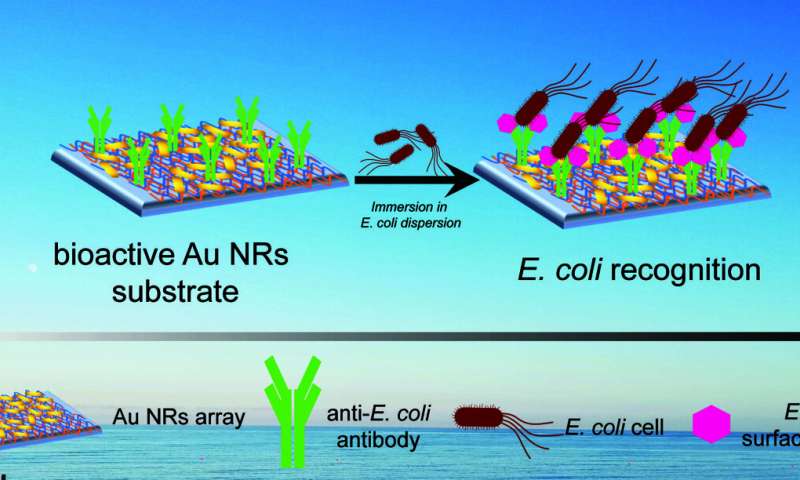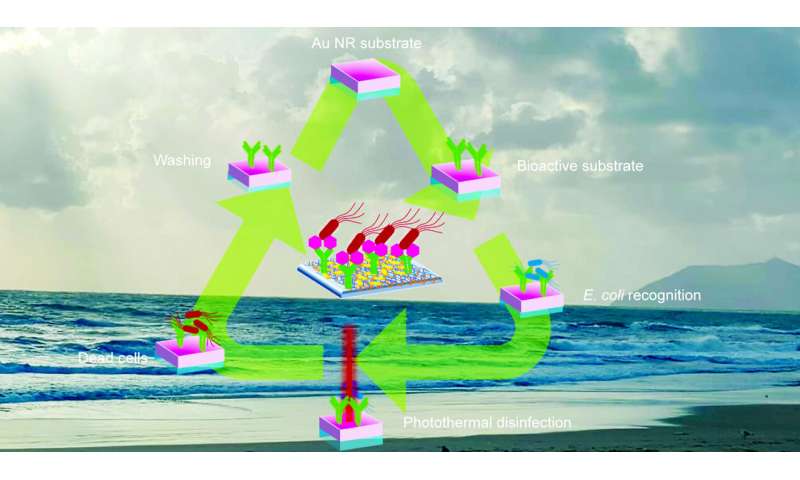Reusable biosensors for the detection of harmful pathogens dispersed in potable water

Drinking contaminated water can lead to waterborne diseases, threatening the lives of many. Intentional contamination of a municipal water system represents a potential target for terroristic activity because of drinkable water's crucial role in everyday life. Early warning systems that monitor the quality of source waters are necessary to protect consumers and reduce the related risks. The main techniques for pathogen detection require expensive equipment, specialized personnel and massive reagent consumption. Biosensors are analytical devices that combine biological components and physicochemical detectors to detect chemical and biological substances.
Nanotechnology, with the help of nanomaterials, provides ground-breaking solutions for realizing compact biosensors that can work as ultra-smart early warning systems that continuously monitor water quality. However, the massive use of disposable biosensors for monitoring source water worldwide could potentially have a strong environmental impact. With the support of the NATO Science for Peace and Security (SPS) Program, we have developed a genuinely innovative reusable biosensor for rapidly detecting harmful pathogens dispersed in drinkable water.
Our label-free biosensor exploits the multifunctional properties and the selectivity of antibody functionalized gold nanoparticles (AuNPs). Indeed, AuNPs, thanks to their chemical and physical properties, have the intrinsic capability to modify their coloration if a variation of the medium surrounding occurs (sensing property). In addition, if excited with a suitable light source (visible or near-infrared light), AuNPs behave as nano heating sources (photothermal property). To realize the desired high sensitivity and reusability, rod-like AuNPs (Au nanorods, Au NRs) are immobilized on a glass substrate and subsequently functionalized with a specific receptor (antibody) that can recognize the specific pathogen we are selectively looking for.
In our experiments, the Au NRs substrate is specifically functionalized with an antibody able to target the surface of Escherichia coli (E. coli), selected as a model pathogen. Results show the antibody's effectiveness in recognizing E.coli cells associated with the antigen/antibody interaction (lock and key analogy) that produces a variation of the medium surrounding Au NRs, and thus, a change of the specific coloration depending on the particular E.coli cells concentration. The realized biosensor exhibits a limit of detection of 8.4 CFU/mL, which is one order of magnitude lower than the conventional plasmonic biosensor already reported in the literature. Recognition experiments performed with other bacteria strains (e.g., Salmonella thyphimurium) confirm the biosensor specificity. Indeed, the biosensor does not show any change in the intrinsic coloration associated with Au NRs.

Suppose drinking water is intentionally or unintentionally contaminated with harmful and specific pathogens. In that case, the realized biosensor can generate a hazardous regime mode, saving lives and avoiding all the related health and economic consequences by alerting competent authorities about contamination.
To give a "second life" to the realized biosensor, thus minimizing the environmental impact, we have exploited the capability of Au NRs to produce heating upon multicolor light disinfection. After the photothermal disinfection process and a suitable washing procedure, the biosensor is ready to be reused for other recognition experiments. Therefore, the proposed biosensor offers a green and sustainable perspective for realizing next-generation biosensors beyond biosensing capability. Indeed, the preparation protocol does not require hazardous chemicals, the unwanted release of pathogens is circumvented, and the Au NRs array can be reutilized, thus representing a magnificent solution in terms of environmental impact and solar light-triggered applications.
Our research was recently published in Environmental Science: Nano, and ongoing studies are oriented to use the proposed biosensor for other applications, such as detecting viruses dispersed in water (e.g., coronavirus) and utilizing the biosensor in controlled microgravity to mimic the space environment conditions, thus opening new opportunities for aerospace security.
This story is part of Science X Dialog, where researchers can report findings from their published research articles. Visit this page for information about ScienceX Dialog and how to participate.
More information: Francesca Petronella et al, Label-free and reusable antibody-functionalized gold nanorod arrays for the rapid detection of Escherichia coli cells in a water dispersion, Environmental Science: Nano (2022). DOI: 10.1039/D2EN00564F
Bio:
Luciano De Sio is an Assistant Professor (tenure track) at the Sapienza University of Rome. He is the group leader of a young and highly motivated research group working in nanotechnology, thermo-plasmonics, liquid crystals, optics, and bio-photonics. He has co-authored 115 ISI-JCR publications in physics and biomedicine, several book chapters, 18 international patents, and delivered more than 50 scientific communications at conferences. He is also the Project Director of an international Multi-Year Project supported by the NATO Science for Peace and Security Program, aiming to realize a nanotechnology-inspired biosensor with photo-responsive liquid crystals. Moreover, Luciano is the principal investigator of an international project (European Office for Aerospace Research and Development, EOARD) supported by the Air Force Office of Scientific Research (AFOSR), Air Force Research Laboratory (AFRL), and the U.S. Air Force. The project aims at realizing a new generation of digital optical network encryption with liquid crystal grating metasurfaces as perfect absorbers.